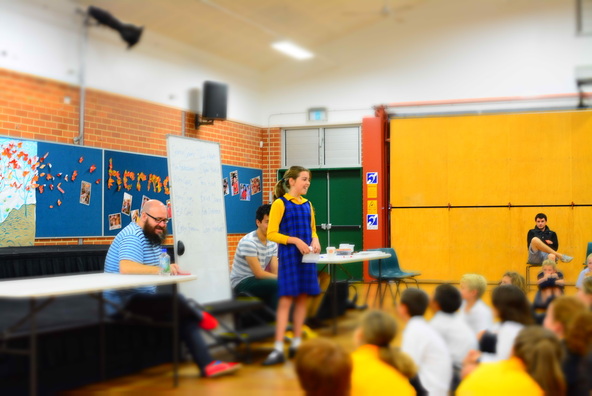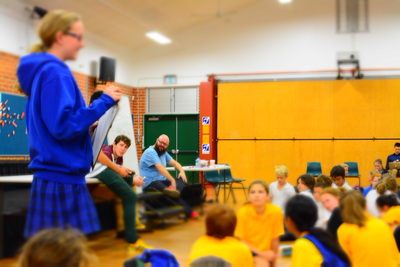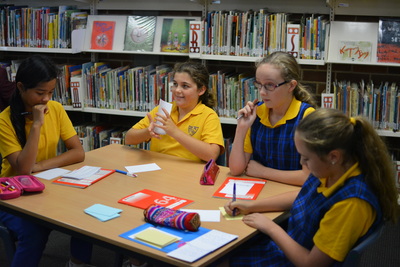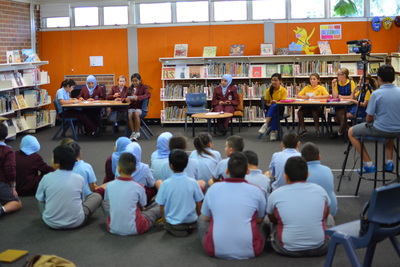Australia Made?
http://www.abc.net.au/btn/story/s2667464.htm
The Skills of Debating
Manner

Manner
Any questions? Think what a normal person would do. Think what a freaky axe murderer would do. Do what the normal person would do!
- Look at people! (You've done it before!)
- Be loud!
- Say "um" if you need to.
Any questions? Think what a normal person would do. Think what a freaky axe murderer would do. Do what the normal person would do!
Method

Debate Team Roles
1st Affirmative
- Context (big problem, topic)s
- Define Topic
- Allocation (like a book chapter, contents)
- Arguments (one idea/reason/point why you are right?)
- Team Line (not that important)
- Go away
1st Negative
- Agree w/ definition
- rebuttal (rebutt each argument)
- allocation (contents, like a book chapter - never allocate the 3rd speaker)
- Arguments
- Team Line
- Go Away
2nd Speakers (easier role)
- Rebuttal (every argument)
- Arguments
- Go Away
3rd Speakers
- Rebuttal
- Rebut more
- Rebut even more
- Rebut much much more
- Rebut just a little more
- Summary (allocation)
- Go away
4th Speaker
- think of rebuttals
- think of more rebuttals
- control team time
- listen and rebut
- Do a thank you speech for the other team
1st Affirmative
- Context (big problem, topic)s
- Define Topic
- Allocation (like a book chapter, contents)
- Arguments (one idea/reason/point why you are right?)
- Team Line (not that important)
- Go away
1st Negative
- Agree w/ definition
- rebuttal (rebutt each argument)
- allocation (contents, like a book chapter - never allocate the 3rd speaker)
- Arguments
- Team Line
- Go Away
2nd Speakers (easier role)
- Rebuttal (every argument)
- Arguments
- Go Away
3rd Speakers
- Rebuttal
- Rebut more
- Rebut even more
- Rebut much much more
- Rebut just a little more
- Summary (allocation)
- Go away
4th Speaker
- think of rebuttals
- think of more rebuttals
- control team time
- listen and rebut
- Do a thank you speech for the other team
WHat's the Matter?

Matter
The way to argue, elaborate and give more detail is to PEEL. Number your PEELs if you have more than one.
Point
- What will you prove?
- Just one sentence
Explain (elaborate)
- what is it like now?
- what will it be like after the topic?
- why is this important?
Example
- a fact from the real world
- no personal examples
- not imaginary
Link
- “And that’s why (topic)
The way to argue, elaborate and give more detail is to PEEL. Number your PEELs if you have more than one.
Point
- What will you prove?
- Just one sentence
Explain (elaborate)
- what is it like now?
- what will it be like after the topic?
- why is this important?
Example
- a fact from the real world
- no personal examples
- not imaginary
Link
- “And that’s why (topic)
But, But!

Rebuttal is the other half of good debating. For this we use SEEL.
Summarise
- Summarise what the other team said
- "The previous speaker said...."
Explain
- They are wrong because (firstly, secondly and thirdly)
Example
- Think of one from real life or/
- Steal the other teams examples and use it against them
- "For example,..."
Link
- “And that’s why…”
Summarise
- Summarise what the other team said
- "The previous speaker said...."
Explain
- They are wrong because (firstly, secondly and thirdly)
Example
- Think of one from real life or/
- Steal the other teams examples and use it against them
- "For example,..."
Link
- “And that’s why…”
INterzone Knockouts
Topic: Sharks Should Be Culled
Affirmative
A response from Julie Anderson regarding the Western Australian proposal to destroy sharks that are found swimming too close to beaches:
It is hard to believe with all we know about sharks, including their dwindling numbers, their critical role in our oceans, and the small risk they actually pose to humans in the grand scheme of things, that the archaic concept of killing these animals solely or our “protection” still exists. And that a country like Australia, whose citizens are known for their enlightened, balanced view of nature. would declare war on sharks – giving the approval to kill any sharks swim near beaches in Western Australia. Even the protected and endangered white shark. All this in a medieval response to five deaths due to shark bites in the past year. At a cost of far more than the $6.35 million that the Australian government is investing in the program. It is absolutely shameful.
Make no mistake. Our hearts go out to the victims’ families. But while these six tragic deaths evoke our primal fears, fueled by media hype, we, as a globally impacted community, still need perspective.
Before overreacting, consider the risk. In the last 215 years in Australia, only 18 shark-related fatalities have occurred. That’s an average of one death every 12 years. In the US, where you are 5 times more likely to be bitten, your odds of drowning are 1 in 3.5 million. Your odds of dying from a shark bite are less than 1 in 264 million. And, in 2008, in Australia, one person died from a shark bite, 315 died from drowning and 694 died in car accidents.
Before killing sharks, the Australian government must also consider their status. Premier Colin Barett is exhibiting bad judgment. Sharks are in danger of extinction; up to 73 million are killed each year. Regionally, over 90% of shark populations– including whites – have been destroyed. White sharks are protected nationally and internationally – and the US is even considering adding them to their endangered species act. Australia is lucky to even have sharks in its waters.
And the world cannot afford to lose sharks. The frightening reality is, like them or not, we need sharks on this planet. As apex predators, they keep our oceans’ healthy. Sharks are a critical component in an ecosystem that controls our planet’s temperature and weather, provides 1/3 of the world with food, and generates more oxygen than all the rainforests combined. Recent studies indicate that regional elimination of sharks caused disastrous effects including the collapse of fisheries and the death of coral reefs. Kill the sharks and Australia’s healthy, beautiful coast will join the countless other ocean dead zones.
Throughout the world, people get into the water, realizing it is us sharing their watery domain, accepting the extremely slim chance of even encountering a shark - much less being bitten. It simply doesn’t merit unnecessarily killing a threatened, critical species.
Continues Andersen, “Not only is the culling absolutely ridiculous, the practice reinforces our misguided and irrational fears of sharks, providing a very real example that our concerns are valid. This in turn fuels one of the biggest issue faced in shark conservation: the public’s apathy or even loathing towards sharks. The media-created and culling reinforced image of sharks makes it difficult for many people to understand why sharks are worth saving – let alone take measures to do so.”
Fortunately, there are many other options to the archaic practice of killing sharks with nets and drumlines, many of which have been implemented successfully in other locations. Other methods of harmless deterrents such as electrical current, alloys, and chemicals are also being developed. States Andersen, “If we can put a man on the moon, we certainly can determine a method to ensure sharks and humans can peacefully coexist in the shark’s domain. Programs like the Shark Spotters in South Africa prove that there are viable alternatives to shark nets and also, that education and awareness go far. “
This issue is not new to Shark Angels, who has been fighting for the end to shark nets and other culling programs for decades. Our “remove the nets” (www.removethenets.com) campaign has been placing pressure on the government of South Africa for over four years rallying the support of thousands.
It could be said there was a time and place for shark culls and nets. Years ago, the public knew little about sharks and the fear of attack was running high – and shark populations were far healthier than they are today. We could tolerate wreaking havoc on our world’s most important ecosystem. The public wanted and needed “protection” and shark culls, drumlins and nets served their purpose.
Since then, while shark fishing has skyrocketed eliminating a large percentage of shark populations, the public has been exposed to much information about the environment and biodiversity conservation as well as the sharks’ true behaviors towards humans. And many have gone far in proving there are other harmless shark deterrents. Shark conservation and the need to protect them is an established fact, as is the fact these animals are significantly misunderstood, with the actual risk of an incident being infinitesimal.
The days of killing animals out of fear are over. And one only need to look at Yellowstone Park, in the U.S., as a prime example as to the far-reaching impacts of these short-sighted acts. Australia - a country whose environmental policies, fueled by booming eco-tourism, should be setting precedence for the world. At a time when we are racing through our natural resources at unsustainable rates, destroying wild animals simply because we can, or because of irrational fears fueled by a lack of knowledge, is no longer acceptable.
Negative
IN 1971, when saltwater crocodiles were first protected, decades of unregulated hunting had reduced their numbers in the Northern Territory to 3000. Now there are more than 100,000 crocs in the Top End and, on average, they are much larger. The consequences are sometimes fatal, as we saw at the weekend with the death of a 12-year-old boy in Kakadu. At least three crocodiles were shot and killed as police and park rangers responded to that tragedy. Each year upwards of 200 "problem" crocodiles posing a threat to humans are captured or killed in the Territory.
Every year along the nation's east coat, hundreds of sharks are killed by nets and baited drum-lines in longstanding programs to protect swimmers at 136 beaches. These shark control measures have proven effective. Between 1919 and 1961, there were 27 reported fatal shark attacks in Queensland; since nets and lines were introduced 53 years ago, there has been one fatality at a controlled beach. It is 60 years since the only NSW death at a netted beach (bodyboarder Zac Young was killed at unprotected Campbells Beach last year). Before the 1930s, deaths occurred at the rate of one a year - and in both states the number of people in the water has at least doubled since the measures began. The controls are not foolproof, with sharks able to swim beneath or around the nets, yet indisputably while thousands of sharks have been killed, many human lives have been saved.
Given this history it is surprising that shark control measures introduced in Western Australia - after seven fatal attacks in three years - are generating such controversy. State Treasurer Troy Buswell, an architect of the drum-line plan, says his government has a duty to protect citizens and he accuses protesters of hysteria. "What amazes me is that these people respond in this way to the WA government's efforts to protect our public, and say nothing about what's been happening in Queensland or NSW for years and years and years," he says. "I mean, it's lunacy." He has a point. Either the protesters value the lives of West Australian sharks more highly than eastern states sharks, or they value the lives of West Australian beachgoers less than swimmers on the east coast.
A similar shark program operates on the South African coast, and around the world dangerous animals from wolves and tigers to brown bears and cobras are killed or captured when close to populated areas. Elsewhere in Australia we don't tolerate funnelwebs under the house or brown snakes in the backyard. So while it is self-evident that the ocean is the great white's domain, as the estuary is for the crocodile, it should go without saying that we should minimise the risk where human populations are high.
On the east coast, common and aggressive bull and tiger sharks are seen as the greatest threat, making up the bulk of sharks killed in control programs. And the first kill in WA was either a bull or tiger shark. Bull sharks continue to thrive in Queensland's Brisbane River and coastal canals, cheek by razor-tooth with large urban population centres. Great white shark populations have proven difficult for scientists to quantify but there is ample anecdotal evidence from fishermen and scientists that numbers and sizes have significantly increased since they were protected in the late 1990s. Previously, unregulated trophy fishing had taken a heavy toll - with the numbers caught declining by up to 90 per cent over time - so it is hardly surprising the population might have recovered. What the WA government is now carrying out is far from open slather. It is a carefully monitored and targeted attempt to control the risks at popular swimming beaches, and it will be subject to environmental assessment and oversight. The evidence is that similar but more extensive programs in the eastern states have prevented many attacks - human lives should be accorded equal value in the west.
Australia's environmental record is one few countries can match. We have rescued many threatened species, including two of the world's most fearsome predators, the great white and the saltie, but we have a right to protect human lives. Activists who seek to prevent lawful shark cull activities should be dealt with under the law.
Affirmative
A response from Julie Anderson regarding the Western Australian proposal to destroy sharks that are found swimming too close to beaches:
It is hard to believe with all we know about sharks, including their dwindling numbers, their critical role in our oceans, and the small risk they actually pose to humans in the grand scheme of things, that the archaic concept of killing these animals solely or our “protection” still exists. And that a country like Australia, whose citizens are known for their enlightened, balanced view of nature. would declare war on sharks – giving the approval to kill any sharks swim near beaches in Western Australia. Even the protected and endangered white shark. All this in a medieval response to five deaths due to shark bites in the past year. At a cost of far more than the $6.35 million that the Australian government is investing in the program. It is absolutely shameful.
Make no mistake. Our hearts go out to the victims’ families. But while these six tragic deaths evoke our primal fears, fueled by media hype, we, as a globally impacted community, still need perspective.
Before overreacting, consider the risk. In the last 215 years in Australia, only 18 shark-related fatalities have occurred. That’s an average of one death every 12 years. In the US, where you are 5 times more likely to be bitten, your odds of drowning are 1 in 3.5 million. Your odds of dying from a shark bite are less than 1 in 264 million. And, in 2008, in Australia, one person died from a shark bite, 315 died from drowning and 694 died in car accidents.
Before killing sharks, the Australian government must also consider their status. Premier Colin Barett is exhibiting bad judgment. Sharks are in danger of extinction; up to 73 million are killed each year. Regionally, over 90% of shark populations– including whites – have been destroyed. White sharks are protected nationally and internationally – and the US is even considering adding them to their endangered species act. Australia is lucky to even have sharks in its waters.
And the world cannot afford to lose sharks. The frightening reality is, like them or not, we need sharks on this planet. As apex predators, they keep our oceans’ healthy. Sharks are a critical component in an ecosystem that controls our planet’s temperature and weather, provides 1/3 of the world with food, and generates more oxygen than all the rainforests combined. Recent studies indicate that regional elimination of sharks caused disastrous effects including the collapse of fisheries and the death of coral reefs. Kill the sharks and Australia’s healthy, beautiful coast will join the countless other ocean dead zones.
Throughout the world, people get into the water, realizing it is us sharing their watery domain, accepting the extremely slim chance of even encountering a shark - much less being bitten. It simply doesn’t merit unnecessarily killing a threatened, critical species.
Continues Andersen, “Not only is the culling absolutely ridiculous, the practice reinforces our misguided and irrational fears of sharks, providing a very real example that our concerns are valid. This in turn fuels one of the biggest issue faced in shark conservation: the public’s apathy or even loathing towards sharks. The media-created and culling reinforced image of sharks makes it difficult for many people to understand why sharks are worth saving – let alone take measures to do so.”
Fortunately, there are many other options to the archaic practice of killing sharks with nets and drumlines, many of which have been implemented successfully in other locations. Other methods of harmless deterrents such as electrical current, alloys, and chemicals are also being developed. States Andersen, “If we can put a man on the moon, we certainly can determine a method to ensure sharks and humans can peacefully coexist in the shark’s domain. Programs like the Shark Spotters in South Africa prove that there are viable alternatives to shark nets and also, that education and awareness go far. “
This issue is not new to Shark Angels, who has been fighting for the end to shark nets and other culling programs for decades. Our “remove the nets” (www.removethenets.com) campaign has been placing pressure on the government of South Africa for over four years rallying the support of thousands.
It could be said there was a time and place for shark culls and nets. Years ago, the public knew little about sharks and the fear of attack was running high – and shark populations were far healthier than they are today. We could tolerate wreaking havoc on our world’s most important ecosystem. The public wanted and needed “protection” and shark culls, drumlins and nets served their purpose.
Since then, while shark fishing has skyrocketed eliminating a large percentage of shark populations, the public has been exposed to much information about the environment and biodiversity conservation as well as the sharks’ true behaviors towards humans. And many have gone far in proving there are other harmless shark deterrents. Shark conservation and the need to protect them is an established fact, as is the fact these animals are significantly misunderstood, with the actual risk of an incident being infinitesimal.
The days of killing animals out of fear are over. And one only need to look at Yellowstone Park, in the U.S., as a prime example as to the far-reaching impacts of these short-sighted acts. Australia - a country whose environmental policies, fueled by booming eco-tourism, should be setting precedence for the world. At a time when we are racing through our natural resources at unsustainable rates, destroying wild animals simply because we can, or because of irrational fears fueled by a lack of knowledge, is no longer acceptable.
Negative
IN 1971, when saltwater crocodiles were first protected, decades of unregulated hunting had reduced their numbers in the Northern Territory to 3000. Now there are more than 100,000 crocs in the Top End and, on average, they are much larger. The consequences are sometimes fatal, as we saw at the weekend with the death of a 12-year-old boy in Kakadu. At least three crocodiles were shot and killed as police and park rangers responded to that tragedy. Each year upwards of 200 "problem" crocodiles posing a threat to humans are captured or killed in the Territory.
Every year along the nation's east coat, hundreds of sharks are killed by nets and baited drum-lines in longstanding programs to protect swimmers at 136 beaches. These shark control measures have proven effective. Between 1919 and 1961, there were 27 reported fatal shark attacks in Queensland; since nets and lines were introduced 53 years ago, there has been one fatality at a controlled beach. It is 60 years since the only NSW death at a netted beach (bodyboarder Zac Young was killed at unprotected Campbells Beach last year). Before the 1930s, deaths occurred at the rate of one a year - and in both states the number of people in the water has at least doubled since the measures began. The controls are not foolproof, with sharks able to swim beneath or around the nets, yet indisputably while thousands of sharks have been killed, many human lives have been saved.
Given this history it is surprising that shark control measures introduced in Western Australia - after seven fatal attacks in three years - are generating such controversy. State Treasurer Troy Buswell, an architect of the drum-line plan, says his government has a duty to protect citizens and he accuses protesters of hysteria. "What amazes me is that these people respond in this way to the WA government's efforts to protect our public, and say nothing about what's been happening in Queensland or NSW for years and years and years," he says. "I mean, it's lunacy." He has a point. Either the protesters value the lives of West Australian sharks more highly than eastern states sharks, or they value the lives of West Australian beachgoers less than swimmers on the east coast.
A similar shark program operates on the South African coast, and around the world dangerous animals from wolves and tigers to brown bears and cobras are killed or captured when close to populated areas. Elsewhere in Australia we don't tolerate funnelwebs under the house or brown snakes in the backyard. So while it is self-evident that the ocean is the great white's domain, as the estuary is for the crocodile, it should go without saying that we should minimise the risk where human populations are high.
On the east coast, common and aggressive bull and tiger sharks are seen as the greatest threat, making up the bulk of sharks killed in control programs. And the first kill in WA was either a bull or tiger shark. Bull sharks continue to thrive in Queensland's Brisbane River and coastal canals, cheek by razor-tooth with large urban population centres. Great white shark populations have proven difficult for scientists to quantify but there is ample anecdotal evidence from fishermen and scientists that numbers and sizes have significantly increased since they were protected in the late 1990s. Previously, unregulated trophy fishing had taken a heavy toll - with the numbers caught declining by up to 90 per cent over time - so it is hardly surprising the population might have recovered. What the WA government is now carrying out is far from open slather. It is a carefully monitored and targeted attempt to control the risks at popular swimming beaches, and it will be subject to environmental assessment and oversight. The evidence is that similar but more extensive programs in the eastern states have prevented many attacks - human lives should be accorded equal value in the west.
Australia's environmental record is one few countries can match. We have rescued many threatened species, including two of the world's most fearsome predators, the great white and the saltie, but we have a right to protect human lives. Activists who seek to prevent lawful shark cull activities should be dealt with under the law.
Round 3
Affirmative
If school days were to last longer, averaging the school to about 10 hours, and abolishing homework, it will help many students! Very hard working students tend to spend most of their after school time going with homework, giving them less time to bond with family or have a social life. If we make school days longer by about a few hours, homework can be covered in school WITH the teacher present (making it easier to help troubled students) and also banning the idea of homework would actually give students MORE time to spend after school. These hours could be used for any curricular activity or just resting and hanging out with family. However, I've only mentioned high school students but I think this method would be good for elementary and middle school students as well. Why? The extra three hours of school could be used for reading (which isn't reinforced well enough in some schools) and also an in-school extra curricular activity like art or music. Classes like these tend to be a relaxing one for students and are more leisure than other classes. It's like a break from learning and doing what you want to do for a class. The long school days shouldn't have that much of an effect of the stress levels of students because once they get home, they can rest easy (because there's no homework, remember?) The reason why students in China, Korea, and Japan have a lot of stress is due to the long hours, extra school days (some students go to school on weekends as well), extra school after their school (yes it sounds weird, but I believe it's called cram school where it's I guess similar to Kumon or maybe just extra school... After school), and in addition to all of that, homework. If we add more hours to school, it will lead to better test scores (overall, yes, most likely it will, but it really depends on the teacher) and less stressed students.
There are a lot of kids struggling in classes. Having longer class time means that a lot more stuff will get finished that might have not because there was too little time. The longer class times doesn't mean that it has to just be the teacher up in front. This could be a time where the teacher walks around asking students if they need help. It could be a homework period. Maybe they have sports. They could get all their homework done if there is longer school days. And teachers worry so much about students not doing homework. This could be the time that the kids who don't do homework do it and not waste time playing video games.
Longer School Days is an Advantage
Longer school days is a really good idea Kids need more time in school.The state tests have changed into a really hard execrable night mare.If we want kids to pass with hundreds we should have longer school days! They need to get better at their ability and spend more time making friends too. Longer school days is an advantage! Yes we should have longer school days
Parents Would Love It
Children are up at 7 am music lesson at 8 till 830 and stay at school till 540 when prep finished they are happy , wonderful children and we don't have the hassle of getting them to practise instruments or do homework ! As a full time worker school holidays are a nightmare this next month my 3 boys are being looked after by some dizzy 17yr old as she was the best I could get without having to remortgage the family home!
Use the Time Well
But First a few things... School days should be longer, but the time needs to be used well. For arts and creative work. Students have had the creativity sucked out of them. They are becoming ROBOTS! They know 2 x 24, but what about poetry, andything creative? More school time wioll only be use ful if used for creativivty.
Negative
School shouldn’t be extended; the hours will increase. With the increase of hours in school, teachers will expect to be paid more. Not only teachers ,but also custodians, secretaries, and other staff members would demand an increase in their pay. Safety is also an issue if the school hours is increased .In the winter time, students would be leaving from school in the dark. It would make it difficult for parents, and require a better bus system, which cost money. Teachers and students will get burned out and it will be difficult for students to participate in after school activities. I disagree school being extended. First of all, school should not be extended because students and teachers will get burned out. Sitting in class for too long will make your head blast , and students is not even going pay attention because they are too tired doing too much work. There are going many homework and less time for students and teaches for their family. Imagine yourself in class getting too tired ignoring teacher, not taking note, and the NJ Ask came you did not past it. Teachers will get tired and wouldn’t want to teach. Without teachers how would students learn.
Overwhelm and stress
Longer school days will overwhelm the student mind. Also, longer school days will cancel school sports leaving only school work. With 24/7 school work, the student brain will get overwhelmed and wont be able to handle the stress. Longer school days are extremely unhealthy for the human brain. Not only that but it will drive our country to bankruptcy, we have to pay our teachers, secretary, janitors, and other staff members mpre if the school days are longer eventually we will be broke because of paying our teachers
No we should have less
I'm a student and i go to school 6 hours a day 5 days a week and I hardly get to see my friends and family from home. I feel like I've learnt all I need to know and I just forget everything anyway so what's the point? Why can't it be shorter? I spend most of my evenings and weekends stressing about homework and I hardly get to spend time with my family or friends who live up my road. It effects our health too because we have to wake up at about 6am every morning which is really stressful and annoying! Also my school is really strict, we are not even aloud makeup or to dye our hair I think school is just stupid and should only be on 3 days a week for 4 hours. I don't think adults understand anymore how stressful kids get from school. Make it shorter!!
Kids need sleep!
Hello, my name is Lark and I am here to talk about how the school day should NOT be longer. Kids need their sleep, as they get older the homework piles up and kids stay up later. Imagine if we started school earlier. For example, imagine if you stayed up until 11:30 doing homework, and had to wake up at 6:00. When you get to school, it would be very hard to pay attention in class. Imagine if your school day was stretched out and longer. If you were that person who went to sleep late that night, you would have a hard time paying attention, especially if the school day was longer. Researchers say, that kids improve in school when they get more sleep. Longer school days means more homework! That means you don’t have much time for activities. For example, again put yourself in someone’s shoes. You go to school from 8:00 to 4:15. That means it adds more classes and more homework. Vicki Ables said “One only has to look at countries like Finland, where students achieve higher test scores with less instruction time and less homework than in our country. The real issue is the quality of the education we’re providing, not the amount of hours spent in a classroom.” The current studies show that more homework, makes kids anxious, and unhealthy. Do you want that to be you? No I didn’t think so. That is why I believe that the school day should not be longer.
If school days were to last longer, averaging the school to about 10 hours, and abolishing homework, it will help many students! Very hard working students tend to spend most of their after school time going with homework, giving them less time to bond with family or have a social life. If we make school days longer by about a few hours, homework can be covered in school WITH the teacher present (making it easier to help troubled students) and also banning the idea of homework would actually give students MORE time to spend after school. These hours could be used for any curricular activity or just resting and hanging out with family. However, I've only mentioned high school students but I think this method would be good for elementary and middle school students as well. Why? The extra three hours of school could be used for reading (which isn't reinforced well enough in some schools) and also an in-school extra curricular activity like art or music. Classes like these tend to be a relaxing one for students and are more leisure than other classes. It's like a break from learning and doing what you want to do for a class. The long school days shouldn't have that much of an effect of the stress levels of students because once they get home, they can rest easy (because there's no homework, remember?) The reason why students in China, Korea, and Japan have a lot of stress is due to the long hours, extra school days (some students go to school on weekends as well), extra school after their school (yes it sounds weird, but I believe it's called cram school where it's I guess similar to Kumon or maybe just extra school... After school), and in addition to all of that, homework. If we add more hours to school, it will lead to better test scores (overall, yes, most likely it will, but it really depends on the teacher) and less stressed students.
There are a lot of kids struggling in classes. Having longer class time means that a lot more stuff will get finished that might have not because there was too little time. The longer class times doesn't mean that it has to just be the teacher up in front. This could be a time where the teacher walks around asking students if they need help. It could be a homework period. Maybe they have sports. They could get all their homework done if there is longer school days. And teachers worry so much about students not doing homework. This could be the time that the kids who don't do homework do it and not waste time playing video games.
Longer School Days is an Advantage
Longer school days is a really good idea Kids need more time in school.The state tests have changed into a really hard execrable night mare.If we want kids to pass with hundreds we should have longer school days! They need to get better at their ability and spend more time making friends too. Longer school days is an advantage! Yes we should have longer school days
Parents Would Love It
Children are up at 7 am music lesson at 8 till 830 and stay at school till 540 when prep finished they are happy , wonderful children and we don't have the hassle of getting them to practise instruments or do homework ! As a full time worker school holidays are a nightmare this next month my 3 boys are being looked after by some dizzy 17yr old as she was the best I could get without having to remortgage the family home!
Use the Time Well
But First a few things... School days should be longer, but the time needs to be used well. For arts and creative work. Students have had the creativity sucked out of them. They are becoming ROBOTS! They know 2 x 24, but what about poetry, andything creative? More school time wioll only be use ful if used for creativivty.
Negative
School shouldn’t be extended; the hours will increase. With the increase of hours in school, teachers will expect to be paid more. Not only teachers ,but also custodians, secretaries, and other staff members would demand an increase in their pay. Safety is also an issue if the school hours is increased .In the winter time, students would be leaving from school in the dark. It would make it difficult for parents, and require a better bus system, which cost money. Teachers and students will get burned out and it will be difficult for students to participate in after school activities. I disagree school being extended. First of all, school should not be extended because students and teachers will get burned out. Sitting in class for too long will make your head blast , and students is not even going pay attention because they are too tired doing too much work. There are going many homework and less time for students and teaches for their family. Imagine yourself in class getting too tired ignoring teacher, not taking note, and the NJ Ask came you did not past it. Teachers will get tired and wouldn’t want to teach. Without teachers how would students learn.
Overwhelm and stress
Longer school days will overwhelm the student mind. Also, longer school days will cancel school sports leaving only school work. With 24/7 school work, the student brain will get overwhelmed and wont be able to handle the stress. Longer school days are extremely unhealthy for the human brain. Not only that but it will drive our country to bankruptcy, we have to pay our teachers, secretary, janitors, and other staff members mpre if the school days are longer eventually we will be broke because of paying our teachers
No we should have less
I'm a student and i go to school 6 hours a day 5 days a week and I hardly get to see my friends and family from home. I feel like I've learnt all I need to know and I just forget everything anyway so what's the point? Why can't it be shorter? I spend most of my evenings and weekends stressing about homework and I hardly get to spend time with my family or friends who live up my road. It effects our health too because we have to wake up at about 6am every morning which is really stressful and annoying! Also my school is really strict, we are not even aloud makeup or to dye our hair I think school is just stupid and should only be on 3 days a week for 4 hours. I don't think adults understand anymore how stressful kids get from school. Make it shorter!!
Kids need sleep!
Hello, my name is Lark and I am here to talk about how the school day should NOT be longer. Kids need their sleep, as they get older the homework piles up and kids stay up later. Imagine if we started school earlier. For example, imagine if you stayed up until 11:30 doing homework, and had to wake up at 6:00. When you get to school, it would be very hard to pay attention in class. Imagine if your school day was stretched out and longer. If you were that person who went to sleep late that night, you would have a hard time paying attention, especially if the school day was longer. Researchers say, that kids improve in school when they get more sleep. Longer school days means more homework! That means you don’t have much time for activities. For example, again put yourself in someone’s shoes. You go to school from 8:00 to 4:15. That means it adds more classes and more homework. Vicki Ables said “One only has to look at countries like Finland, where students achieve higher test scores with less instruction time and less homework than in our country. The real issue is the quality of the education we’re providing, not the amount of hours spent in a classroom.” The current studies show that more homework, makes kids anxious, and unhealthy. Do you want that to be you? No I didn’t think so. That is why I believe that the school day should not be longer.
Round 1

That school canteens should be allowed to sell any food or drink.
Debate link:
http://www.debate.org/opinions/should-schools-sell-junk-food
Debate link:
http://www.debate.org/opinions/should-schools-sell-junk-food
Round 2

Topic: That Contact Sports Should Be Banned in Schools!
Readings:
http://www.debate.org/debates/Football-should-be-banned-as-an-organized-sport-for-high-school-students/1/
http://www.bigfooty.com/forum/threads/that-contact-sports-should-be-banned-in-schools.37133/
Brain Injuries from SportsBy
Contact Sports vs. Non Contact Sports: How Widely Do They Differ?
Head injuries are quite common and occur regularly in all contact sports. Concussions, from brain injuries can cause long term effects and can lead to dementia. Too many concussions occur in school athletes that participate in contact sports. One may suggest that contact sports should be banned from all schools. Non contact sports should become a part of the physical education curriculum so that young adults should not have to suffer the consequences from head injuries in contact sports.
There are a large number of dangerous contact sports that athletes participate in today. Examples of the most common contact sports include: football, basketball, soccer, wrestling, field hockey, and lacrosse. Research suggests that these sports have the most severe injuries. School students that participate in contact sports are endangering their health, lives, and future.
Football is widely viewed by millions of spectators season after season. Recent research shows that “school players sustained 43 head injuries from 1995-2004 in which there was incomplete recovery and players sustained five head injuries from 1995-2004 in which there was incomplete recovery“ (“Sports-Related Head Injuries” 3). These statistics are important because they show how football can be considered unsafe for young athletes. If football was abolished from schools there would be a significant decrease in the amount of head injuries in not only high school athletes, but college athletes as well. This is because a lot of universities recruit star athletes from their school teams. When there is an absence of school teams, the amount of head injuries in college students will decrease. League officials have also stated that “there are about 160 concussions in the National Football League every year“ (Sports-Related Head...
Growth Plate Injuries
Children's bones are constantly growing. Growth accelerates during puberty before coming to an end in adulthood, but bones add material only in special regions called growth plates, located near the ends of bones and points where tendons and ligaments connect to the bone. Growth plates resemble cartilage in their structure and texture before transitioning into mature, solid bone. The longer bones of the legs and arms experience the most pronounced growth, while growth plates located elsewhere influence the contours of bones. Bone fractures that extend into the growth plate run the risk of causing permanent deformity or stunting. In most cases, however, doctors are able to set the bones properly and restore normal blood flow. Crushing injuries, though relatively rare in sports, represent the greatest potential for permanent disability.
Contact Sport Should be Allowed!
While I concede that football remains a dangerous sport, I do not believe that it should be banned for high school students. All steps should be taken to ensure that we balance safety with the spirit of the game, and while current attention to the relationship between football and head trauma deserves merit, most of the sport"s very vocal critics do not in any way support a ban.
First, simply put, we don"t ban dangerous, voluntary activities. People die in car accidents, yet we don"t ban cars. High caloric meals from fast food restaurants can cause debilitating obesity. Even dangerous wildlife can pose a threat, but we don"t ban access to certain environments because those places could be harmful. This list is endless, but the similarity crucial. Voluntary activities that could be harmful to you tend not to be banned, and for good reason; we honor the freedom to participate, cherishing the idea that individual responsibility should come before governmental mandate. If you support the idea that a voluntary activity should be banned because it is potentially harmful, you have logically justified a rollback of many different potential activities and freedoms. The risk of death and injury, while important, isn"t enough to justify a ban on high school football.
Second, you are ignoring the benefits of football " teambuilding, camaraderie, trust, and of course, keeping in shape. So many people can participate in football because it is a dynamic game: some kick, some throw, some catch, some run, some block guys trying to tackle your guys. Sports like basketball, baseball, or soccer are not as dynamic, which is why these sports tend to have fewer players on the team.
Third, high school football exists because there is a demand. Adults and students alike enjoy the passion, suspense, and even the roughhousing. Even if you ban high school football, the demand will not die. People love the game, and it is not entirely inconceivable that this desire to play means that more people would participate in a lot of smaller, unofficial football games played in back lots and yards, which could be even more dangerous since the rules would be less strictly enforced and the students would not have access to safety equipment. If students want to play football, they will find a way.
Fourth, much of your post devotes itself to enumerating other activities that should be expanded or funded in light of ending football, but this plank of your argument simply isn"t topical. The question surrounds high school football, not whether other activities should be funded or how much, and you have not demonstrated that football specifically trades off with other activities. A debate team, for example, may not exist because there is little interest in the sport amongst students. I know this was true at least for my school at one point. Football programs are funded so much because they are popular: there are many spectators to entertain and many students who want to participate. Specifically, your resolution is not about whether we should fun artsy activities more.
Readings:
http://www.debate.org/debates/Football-should-be-banned-as-an-organized-sport-for-high-school-students/1/
http://www.bigfooty.com/forum/threads/that-contact-sports-should-be-banned-in-schools.37133/
Brain Injuries from SportsBy
Contact Sports vs. Non Contact Sports: How Widely Do They Differ?
Head injuries are quite common and occur regularly in all contact sports. Concussions, from brain injuries can cause long term effects and can lead to dementia. Too many concussions occur in school athletes that participate in contact sports. One may suggest that contact sports should be banned from all schools. Non contact sports should become a part of the physical education curriculum so that young adults should not have to suffer the consequences from head injuries in contact sports.
There are a large number of dangerous contact sports that athletes participate in today. Examples of the most common contact sports include: football, basketball, soccer, wrestling, field hockey, and lacrosse. Research suggests that these sports have the most severe injuries. School students that participate in contact sports are endangering their health, lives, and future.
Football is widely viewed by millions of spectators season after season. Recent research shows that “school players sustained 43 head injuries from 1995-2004 in which there was incomplete recovery and players sustained five head injuries from 1995-2004 in which there was incomplete recovery“ (“Sports-Related Head Injuries” 3). These statistics are important because they show how football can be considered unsafe for young athletes. If football was abolished from schools there would be a significant decrease in the amount of head injuries in not only high school athletes, but college athletes as well. This is because a lot of universities recruit star athletes from their school teams. When there is an absence of school teams, the amount of head injuries in college students will decrease. League officials have also stated that “there are about 160 concussions in the National Football League every year“ (Sports-Related Head...
Growth Plate Injuries
Children's bones are constantly growing. Growth accelerates during puberty before coming to an end in adulthood, but bones add material only in special regions called growth plates, located near the ends of bones and points where tendons and ligaments connect to the bone. Growth plates resemble cartilage in their structure and texture before transitioning into mature, solid bone. The longer bones of the legs and arms experience the most pronounced growth, while growth plates located elsewhere influence the contours of bones. Bone fractures that extend into the growth plate run the risk of causing permanent deformity or stunting. In most cases, however, doctors are able to set the bones properly and restore normal blood flow. Crushing injuries, though relatively rare in sports, represent the greatest potential for permanent disability.
Contact Sport Should be Allowed!
While I concede that football remains a dangerous sport, I do not believe that it should be banned for high school students. All steps should be taken to ensure that we balance safety with the spirit of the game, and while current attention to the relationship between football and head trauma deserves merit, most of the sport"s very vocal critics do not in any way support a ban.
First, simply put, we don"t ban dangerous, voluntary activities. People die in car accidents, yet we don"t ban cars. High caloric meals from fast food restaurants can cause debilitating obesity. Even dangerous wildlife can pose a threat, but we don"t ban access to certain environments because those places could be harmful. This list is endless, but the similarity crucial. Voluntary activities that could be harmful to you tend not to be banned, and for good reason; we honor the freedom to participate, cherishing the idea that individual responsibility should come before governmental mandate. If you support the idea that a voluntary activity should be banned because it is potentially harmful, you have logically justified a rollback of many different potential activities and freedoms. The risk of death and injury, while important, isn"t enough to justify a ban on high school football.
Second, you are ignoring the benefits of football " teambuilding, camaraderie, trust, and of course, keeping in shape. So many people can participate in football because it is a dynamic game: some kick, some throw, some catch, some run, some block guys trying to tackle your guys. Sports like basketball, baseball, or soccer are not as dynamic, which is why these sports tend to have fewer players on the team.
Third, high school football exists because there is a demand. Adults and students alike enjoy the passion, suspense, and even the roughhousing. Even if you ban high school football, the demand will not die. People love the game, and it is not entirely inconceivable that this desire to play means that more people would participate in a lot of smaller, unofficial football games played in back lots and yards, which could be even more dangerous since the rules would be less strictly enforced and the students would not have access to safety equipment. If students want to play football, they will find a way.
Fourth, much of your post devotes itself to enumerating other activities that should be expanded or funded in light of ending football, but this plank of your argument simply isn"t topical. The question surrounds high school football, not whether other activities should be funded or how much, and you have not demonstrated that football specifically trades off with other activities. A debate team, for example, may not exist because there is little interest in the sport amongst students. I know this was true at least for my school at one point. Football programs are funded so much because they are popular: there are many spectators to entertain and many students who want to participate. Specifically, your resolution is not about whether we should fun artsy activities more.






